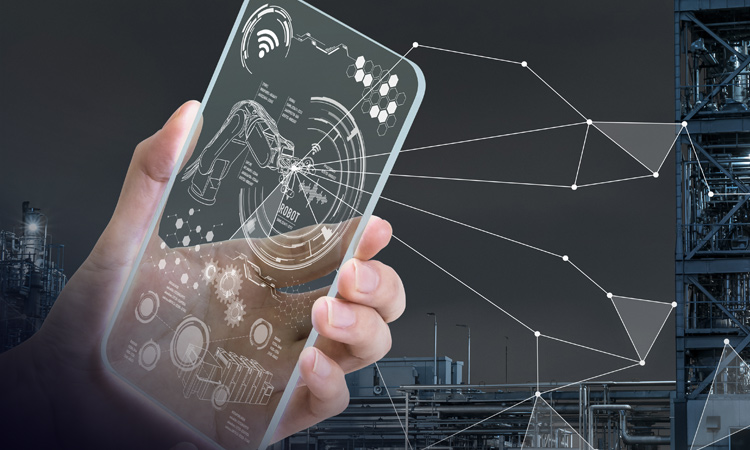 [Getty Images]
[Getty Images]
Fridges that order groceries when stocks run low. Offices that regulate heating and lighting to maximize energy efficiency. Cars that drive and park themselves. Wristwatches that monitor heartbeat and other vital signs.
These are a few of the many applications of the much-discussed Internet of Things (IoT). Under that vision, machines, buildings and infrastructure—usually kitted out with sensors and possibly actuators, as well as a rudimentary processor, a power supply and an antenna to send and receive data—will communicate with one another across the internet. The data in those communications, typically stored and analyzed at a central hub, might relay the temperature of a machine on a factory floor, the strain on a stretch of railway track or the blood sugar levels inside a diabetic patient—all to make our lives more comfortable and productive.
Many experts believe that the sector likely to become most important is the so-called Industrial Internet of Things (IIoT).
That beguiling vision has led many market research firms and tech companies to make extravagant forecasts. In 2013, International Data Corporation predicted that global revenues from the IoT, which it estimated at US$4.8 trillion in 2012, would reach US$8.9 trillion in 2020. In 2014, the global I.T. firm Cisco declared the IoT to be “potentially the biggest business opportunity in the history of mankind.”
In one sense an internet of things already exists; alongside the roughly 3.5 billion computers, smartphones and other human-oriented devices hooked to the internet in 2016, there were some 14 billion “things,” according to the semiconductor market research company IC Insights. Yet most of those installed objects, IC Insights’ senior analyst Rob Lineback explains, lack the advanced functionality associated with the IoT vision. The IoT’s actual economic returns thus far, meanwhile, have been fairly modest; IC Insights estimates that sales of IoT hardware and software last year (excluding services) totalled US$75 billion, of which just US$1.6 billion came from sales of devices in the high-profile home market. “Some people have gone crazy with the numbers they are projecting,” says Lineback.
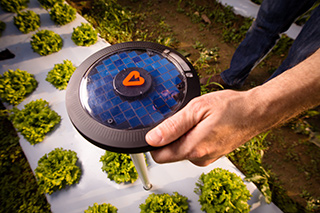 [Arable Labs Inc.]
[Arable Labs Inc.]
Down on the farm
Some farms already have sensors installed in their fields—and by uploading data from these sensors to the internet, farmers can, in principle at least, tightly control their fertilizer, water and pesticide use, and kill off any disease before it becomes a plague. But this branch of the IoT is still in its infancy, according to Adam Wolf, a biologist formerly with Princeton University, N.J., USA. He says that less than 10 percent of U.S. farms employ such technology, and points out that one recent survey cited agriculture as the country’s least digitized economic sector.
Wolf has set up a company, Arable, that markets a disk-shaped mountable device housing multiple sensors and linked to cloud-based analysis. The idea, he says, is to give farmers more understandable, usable information on the timing, yield and quality of harvests. Silicon photodiodes measure incoming visible radiation, which reveals both the energy available for photosynthesis and the amount of energy plants dissipate through evaporation. By combining that information with data from a spectrometer, which measures the tiny amount of energy actually used for photosynthesis, the setup reveals how efficiently plants produce biomass.
Integrating that information with a web-based weather forecast makes it possible to predict how much biomass the plants will produce within the next week. In this way, says Wolf, farmers can better plan hay-cutting schedules, or harvest strawberries only when they are at their sweetest.
Wolf admits that trying to sell the technology to a “typical” farmer—in their fifties, with years of practical knowledge behind them—is a tough proposition. Over time, though, he believes they’ll be won over by the more technically minded agronomists who advise them. The fact that there are still relatively few sensors installed in fields, he says, “provides a huge potential for growth.”
Indeed, David Blaauw, an electrical engineer at the University of Michigan, USA, argues that the IoT is approaching the “trough of despair,” an expression coined by the market research firm Gartner Inc. to describe the point when excessive expectations for a technology’s prospects give way to disillusionment. The despair, he suggests, relates partly to a lack of consumer demand and partly to shortcomings with the current technology. High-profile IoT failures—smartphone-operated locks that leave the front door open; internet-connected thermostats that switch off unexpectedly in the middle of a cold snap—made potential buyers wary, Blaauw notes.
But the despair shouldn’t last. Many industry experts reckon that the IoT should start to take off over the next few years, with Gartner predicting that the sector should reach what it calls the “plateau of productivity” by about the mid-2020s. This underlying confidence is reflected in record levels of acquisitions—about US$100 billion a year—within the semiconductor industry over the last two years, as firms such as Qualcomm and Intel have sought to counteract sluggish sales of smartphones and personal computers by buying businesses more oriented toward wireless sensor networks, wearable electronics, self-driving vehicles and other IoT-related applications. “This is one potential for growth, and they don’t want to miss out,” says Blaauw.
From the city to the factory
Collecting and processing data automatically from objects is not new. Telemetry has been used for more than a century to transmit operational information from afar, while devices such as dishwashers and ATMs are run by purpose-built, embedded computer systems. But only in around the last decade, according to Russell Irving, a chief engineer at GE Global Research, have low-power processors, cheap sensors, high bandwidth and diffuse wireless services combined to make a ubiquitous, interconnected network of devices appear realistic—and potentially lucrative.
Today, nearly 60 percent of IoT hardware revenue, or some US$44 billion, comes from urban usage, according to IC Insights. Applications range from sensor-equpped traffic lights, to real-time information on the location of public buses, to air and water quality monitoring at the level of individual houses, to pattern recognition in video surveillance footage to identify suspicious behavior.
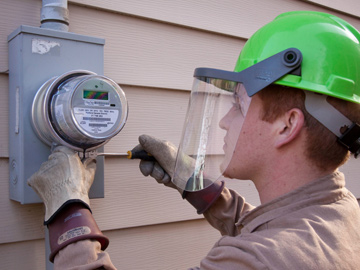 Smart electrical grids have generated a significant fraction of the revenue for the IoT to date. Here, a technician installs a new smart meter at a house in Portland, Oregon, USA. [Portland General Electric]
Smart electrical grids have generated a significant fraction of the revenue for the IoT to date. Here, a technician installs a new smart meter at a house in Portland, Oregon, USA. [Portland General Electric]
Particularly significant has been the development of smart electrical grids, including smart meters in residences and sensor arrays in substations and on power lines, to better match supply with demand. Governments around the world introduced subsidies in this area to get their economies going after the financial crisis in 2008; China alone has pumped more than US$7 billion into smart grids in the past five years, according to Lineback. Private investment is increasing and the sector will continue to grow, he says, but not as quickly as the market for IoT products as a whole.
Yet many experts believe that the sector likely to become most important is the so-called Industrial Internet of Things (IIoT). The IIoT idea holds that, by extracting and analyzing vast quantities of data from all sorts of industrial infrastructure—factory machines, power station turbines, hospital equipment, containers on cargo ships—companies can boost productivity and reduce costs. IC Insights predicts that the value of the IIoT will expand from roughly US$16 billion at present to some US$37 billion in 2020.
In factories, sensors on equipment can record a range of parameters, such as a machine’s temperature and the number of hours it’s been operating, so that settings and workflows across the factory can be tweaked to reduce bottlenecks. Another major IIoT application will be “predictive maintenance,” which involves analyzing machine data to anticipate when a device might break down—and fix it before it does.
Some companies already employ similar features in their factories. For example, General Motors has improved its painting operations by using humidity sensors; if the humidity in one area of its plant isn’t right, the vehicle parts are rerouted to another area to limit the need for repainting. Companies will have to install new hardware to realize the IIoT’s benefits, according to the management consulting firm McKinsey & Co., but the required overhaul will often be fairly limited, as many factory machines either already have appropriate sensors or can be retrofit with them. That, according to McKinsey, contrasts sharply with earlier industrialization, when the arrival of steam power forced the replacement of more than 80 percent of installed equipment.
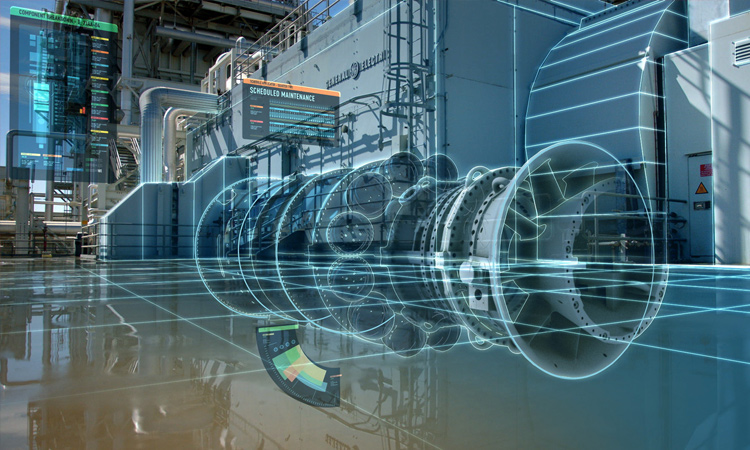 GE has developed virtual replicas of physical objects known as “digital twins”—such as this one of a gas turbine in a power plant—to better understand those objects’ performance and carry out preventative maintenance where necessary. [General Electric]
GE has developed virtual replicas of physical objects known as “digital twins”—such as this one of a gas turbine in a power plant—to better understand those objects’ performance and carry out preventative maintenance where necessary. [General Electric]
The IIoT’s potential has prompted major industrial companies such as Siemens and General Electric (GE) to begin melding their traditional physical manufacturing businesses with digital technology. GE, which has invested more than US$4 billion in this area, has developed cloud-based software called Predix that allows both GE engineers and other users outside the company to create industrial apps tailored to particular pieces of hardware. One such app controls the relative orientation of blades across a group of wind turbines to maximise power output as the wind changes; another calculates the extra maintenance costs a utility might incur as it raises a power station’s output to meet growing demand.
GE uses what it calls “digital twins,” computer models designed to provide exact, virtual replicas of specific physical objects. The company is currently creating digital twins for each of the roughly 34,000 aircraft jet engines that it has built. According to GE’s Irving, that will allow it to better analyze data generated by the dozens of sensors in each engine in order to flag potential malfunctions. “All engines age at slightly different rates depending on their usage,” he says. So the ability to model particular engines, rather than generic ones, should reduce the number of false alarms.
Other business sectors ripe for bottom-line improvement from the IoT include agriculture and the management of remote worksites. According to McKinsey, operators of offshore oil rigs already use thousands of sensors to monitor drilling, but fail to analyze the resulting data properly; doing so, the consulting firm says, could increase the fraction of time that rigs are operational. McKinsey argues that mining companies also could benefit from going digital—for example, by using proximity sensors to automatically switch off sensitive or dangerous equipment when workers get too close.
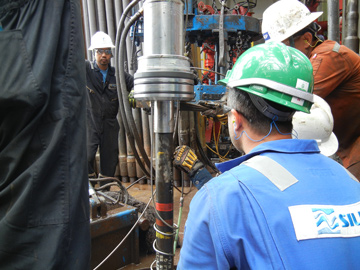 Fiber optic cables are sent down deep wells to gather data during seismic surveys of oil and gas deposits. The fibers, which measure stress and temperature via Rayleigh scattering, can take data along their entire length. [Silixa Ltd.]
Fiber optic cables are sent down deep wells to gather data during seismic surveys of oil and gas deposits. The fibers, which measure stress and temperature via Rayleigh scattering, can take data along their entire length. [Silixa Ltd.]
Powering up the IoT
For the IoT to reach its full potential, though, it will need to overcome a number of challenges, technical and nontechnical. One of the most basic is accessing electrical power. Richard Haight, a physicist at IBM’s T.J. Watson Research Center in Yorktown Heights, N.Y., USA, says that most of the “things” in use today, such as modern sensor-filled cars or home thermostats, are wired up to a power source. But autonomous devices in remote locations, such as sensors that monitor pollution in rivers or methane at oil wells, will not have a ready source of power.
Conventional (and bulky) batteries are not ideal, says Haight. Instead, he is working on thin-film solar cells based on Earth-abundant materials including copper, zinc, tin and sulfur. The cells are less than 13 percent efficient, but are cheap and non-toxic—which, he says, is vital if they are to remain in the field for good once deployed. Adding small amounts of other elements, such as silver or germanium, might boost cells’ efficiency by mitigating certain defects, he adds.
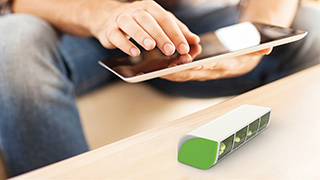 A sensor-equipped “smart pillbox.” [Courtesy of Tricella]
A sensor-equipped “smart pillbox.” [Courtesy of Tricella]
Up close and personal
In addition to monitoring the external world, the IoT is being used to keep a closer eye on human beings—and, potentially, to treat people with chronic diseases such as diabetes. Stand-alone devices such as scales or smart pillboxes, and wearable devices such as blood glucose meters and blood pressure cuffs, can send data wirelessly to help doctors both better monitor patients’ treatment regime and to spot signs of potentially serious deteriorations ahead of time. For example, a sudden increase in weight of a person who suffers from chronic heart failure could indicate increased fluid retention that precedes a collapse.
Although at a slightly earlier stage of development, patients could someday be treated and monitored with tiny devices that are ingested, injected or implanted. Pills containing tiny cameras can be swallowed to record images of the inside of someone’s digestive tract, while in the future tiny nanobots might be able to clear arteries and help detect or monitor cancer.
In addition, as with fitness trackers sold today, IoT devices could also be used to carry out “preventative maintenance” of healthy individuals. Measurements of blood oxygen, glucose and calorie consumption could lead to recommendations concerning exercise or diet. Meanwhile, says David Blaauw of the University of Michigan, USA, measurements of ambient light might be used to prevent depression (in the case of too little light) or skin cancer (when there is too much). With several dozen sensors located on and in the body, everything that a person eats, drinks and breathes, and even what company they keep, could be monitored. “Those are all important factors in a person’s health,” he says.
Another challenge in developing the IoT is minimizing the power consumption of sensing devices in the first place, as well as making the devices as cheap as possible. Here, the advent of microelectromechanical systems (MEMS) could help. MEMS have become ubiquitous thanks to their use in smartphones, where they find use as accelerometers, gyroscopes, pressure sensors, microphones and more. Consisting of mechanical-based components as small as a micron across, plus associated microelectronics, MEMS can be made cheaply using CMOS mass-production processes.
Jason Gorman, a mechanical engineer at the National Institute of Standards and Technology (NIST) in Gaithersburg, Md., USA, is working on a project to merge photonics with MEMS. Gorman points out that although MEMS are very sensitive given their size, the capacitive and piezoresistive techniques used to measure the internal motion of MEMS components are not as sensitive as laser interferometry, while calibration is time consuming and prone to drift over time. Gorman and colleagues have developed a MEMS accelerometer that contains a tiny Fabry–Pérot cavity for transducing displacement, which, he says, can be calibrated by characterizing the cavity’s optical spectrum and by knowing the wavelength of the laser used. “Even an inexpensive laser can have sufficient wavelength stability for calibrating the sensor,” he says.
Such sensor technology, of course, is a linchpin of the IoT—and fiber optic sensing in particular could constitute a huge opportunity, in the view of some experts (see “Optics Innovations,” p. 18). As Philip Ji and Ting Wang of NEC in Princeton point out, fiber optic sensors are very sensitive, quick operating and robust, being immune to electromagnetic interference and able to withstand harsh conditions. In addition, some devices can make multiple measurements along their length owing to the fact that light backscatters continually as it propagates down the fiber. Different phenomena can be exploited to measure a wide range of physical quantities—evanescent loss (and other parameters) in the case of temperature, Rayleigh scattering for vibration, Brillouin scattering for strain.
The oil and gas industries already use fiber optic sensors to look for new resources over wide areas, exploiting Rayleigh scattering to detect acoustic waves that bounce back from within the Earth’s crust during seismic surveys. According to Gorman, these distributed fiber optic sensor networks could be a natural fit for the IoT. “You could have a sensor that can work on the same fiber optic cables used for communication networks,” he says.
Sensor technology, of course, is a linchpin of the IoT—and fiber optic sensing in particular could constitute a huge opportunity, in the view of some experts.
The road to reality
Beyond the core hardware, the IoT presents many other challenges. One is the sheer volume of data that it could bring onto the global fiber network, and how that network will cope. Cisco, in its 2017 white paper “The Zettabyte Era,” forecasts that global machine-to-machine (M2M) Internet Protocol (IP) traffic could expand at a compound annual rate of 49 percent over the next five years, from around 2 exabytes in 2016 to more than 14 exabytes in 2021. And, though the latter number amounts to only 5 percent of projected total IP traffic from all sources, it’s twice the share represented by M2M traffic in 2016—an indication of the IoT’s potential talent for eating up bandwidth in years to come.
The intersection of IoT technology with human concerns also raises important issues. Driverless vehicles must continuously process vast amounts of complex data to ensure a trouble-free, and safe, ride—which may put a premium on emerging deep-learning, neural-net approaches to computing. Another concern is security. As McKinsey points out, IoT breaches could be more serious than those of the existing internet, given the potential for physical harm—cars that go haywire or water treatment plants that break down. A malware attack last October highlighted this vulnerability, as simultaneous data requests from large numbers of hijacked webcams and digital video recorders overwhelmed the servers of Internet infrastructure provider Dyn, bringing down the websites of high-profile companies such as Facebook.
And, of course, there is the thorny issue of privacy—which might prove especially problematic for domestic and personal applications such as improving human health. In addition to establishing clear rules about data accessibility and ownership, Blaauw points out that some processing could be carried out in devices rather than in the cloud, to limit the transmission of raw, sensitive personal data.
The IoT’s success will also hinge on finding ways to get different devices to talk to one another. While several groups of companies are working to develop standard protocols and software to enable interoperability, so far no universal standard has emerged.
Success on this front, though, might finally lead to the long-promised vision of IoT-connected homes, according to Blaauw. For example, he suggests, smart thermostats linked to smart meters could monitor variations in the price of electricity—as utilities seek to tailor demand to an increasingly variable, renewables-based supply—and also even predict future prices. By turning devices on or off slightly earlier or later than otherwise, thermostats could in principle save homeowners a lot of money, he points out. “There are greater opportunities as more of these things integrate together,” he says. “Maybe their value isn’t initially that high but it gets higher over time.”
Lineback of IC Insights, too, believes that the long-run prospects for the IoT look solid. He notes that while some of the key elements needed to make the IoT a success, such as technical standards, “have still to fall into place,” others, such as data analysis, are maturing quickly. That confidence is reflected in his company’s most recent market forecast, which projects that revenues for IoT equipment will grow from US$75 billion in 2016 to US$128 billion in 2020. “The numbers might not seem so big, but our feeling is that this is an important game changer,” he says. “The IoT is beginning to feel more like reality as we move forward.”
Edwin Cartlidge is a freelance science journalist based in Rome.
References and Resources
-
McKinsey Global Institute. “Unlocking the potential of the Internet of Things,” www.mckinsey.com (2015).
-
R. Haight et al. “Solar-powering the Internet of Things,” Science 353, 124 (2016).
-
P.N. Ji and T. Wang. “Internet of Things with optical connectivity, networking and beyond, IEEE 21st Optoelect. Comms. Conf. (2016).
-
Y. Bao et al. “An optomechanical accelerometer with a high-finesse hemispherical optical cavity,” IEEE Intl. Symp. Inert. Sens. Sys. (2016).
-
Cisco Systems, Inc. “The Zettabyte Era: Trends and Analysis,” www.cisco.com (updated 7 June 2017).
